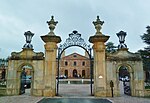Hun School of Princeton
1914 establishments in New JerseyBoarding schools in New JerseyEducational institutions established in 1914Hun School of Princeton alumniMiddle States Commission on Secondary Schools ... and 6 more
New Jersey Association of Independent SchoolsPrivate high schools in Mercer County, New JerseyPrivate middle schools in New JerseySchools in Princeton, New JerseyUse American English from October 2020Use mdy dates from December 2020

The Hun School of Princeton is a private, coeducational, secondary boarding school located in Princeton in Mercer County, New Jersey, United States. The school serves students from sixth through twelfth grades. The school has been accredited by the Middle States Association of Colleges and Schools Commission on Elementary and Secondary Schools since 1963 and is accredited until January 2025. The acceptance rate for the school has been reported as 35%. It is also a member of the New Jersey Association of Independent Schools.The head of school is Bart Bronk, who took the position in July 2023, following Jon Brougham, who had served for 14 years in the position.
Excerpt from the Wikipedia article Hun School of Princeton (License: CC BY-SA 3.0, Authors, Images).Hun School of Princeton
Stony Brook Trails,
Geographical coordinates (GPS) Address Website External links Nearby Places Show on map
Geographical coordinates (GPS)
| Latitude | Longitude |
|---|---|
| N 40.337 ° | E -74.686 ° |
Address
Hun School of Princeton
Stony Brook Trails 176
08540
New Jersey, United States
Open on Google Maps









